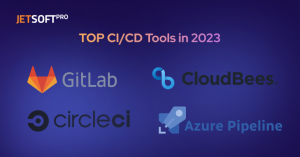In the dynamic world of software development, speed reigns supreme. The tech industry is super competitive, and a company’s success often depends on how quickly it can create advanced software. In this article, we’ll talk about ways to make the software development process better, giving businesses a good head start in the race to finish quickly.
Embrace Agile Methodologies
Agile methods like Scrum and Kanban have transformed how we develop software. They come with a bunch of benefits, like being flexible, improving communication, and making sure we build stuff that users want. If you’re interested in further exploring Agile methodologies and diving deeper into the strategies companies can implement to accelerate their software development process, we recommend checking out our article: The Role of Agile Methodology in Startup Software Development .
Here’s a simple example: Scrum divides work into smaller, focused chunks called sprints that usually last two to four weeks. This helps teams stay focused on the most important tasks, getting new features to users more quickly. In contrast, Kanban uses a visual system to ensure work moves smoothly, preventing bottlenecks and using resources efficiently.
Prioritize Requirements and Plan Effectively
In any software development project, clear and well-defined requirements are the cornerstone of success. Proper planning, including the use of user stories and well-structured backlogs, plays a pivotal role in preventing scope creep and delays.
User stories help capture the functional and non-functional requirements from an end-user perspective, enhancing communication between developers, product owners, and other stakeholders. A well-structured backlog acts as a roadmap, ensuring that the most critical features are tackled first.
Project managers play a crucial role in efficient planning and resource allocation. They ensure that the team is aligned with the project’s goals and has the resources they need. This may involve breaking down complex projects into manageable tasks, scheduling sprints, and setting clear milestones.
By keeping a vigilant eye on project progress, project managers can quickly identify and mitigate issues that could otherwise lead to delays. Their guidance is instrumental in ensuring that the development process remains on track and in alignment with the business’s objectives.
Automation and Continuous Integration/Continuous Deployment (CI/CD)
Automation plays a pivotal role in modern software development. By automating repetitive tasks, it reduces human error, saves time, and enhances the overall development process. This is particularly evident in software testing, deployment, and code integration.
Continuous Integration (CI) and Continuous Deployment (CD) pipelines are a game-changer. They streamline the development process by automating testing, building, and deployment tasks. This reduces the need for manual interventions, ensuring that code changes are quickly and consistently delivered to production.

In the realm of automation, several tools and practices are indispensable. Jenkins, Travis CI, and Docker are among the most popular choices, simplifying tasks like code compilation, testing, and containerization. These tools promote a consistent and efficient development pipeline.
Cross-Functional Teams and Collaboration
In today’s software development world, the lone developer working in isolation is a rarity. The focus has shifted to cross-functional teams that bring together developers, testers, and other stakeholders to work collaboratively. Real-time collaboration and feedback are the cornerstones of this approach.
Collaboration allows for quicker problem-solving and decision-making. When team members from diverse backgrounds work together, they can draw from a wide range of expertise to resolve issues efficiently. The ability to provide immediate feedback leads to faster iterations and improved software quality.
Collaboration isn’t just about working together; it’s about doing it effectively. Techniques like pair programming, where two developers code together, and code reviews, where team members assess each other’s work, ensure that a critical eye is always on the project, resulting in a more robust end product.
DevOps Practices
DevOps is a cultural and technical shift that unites development and operations teams. It promotes a collaborative and streamlined approach to software development, where development and IT operations work hand-in-hand to achieve automation, faster deployment, and improved scalability.
DevOps practices often involve concepts like Infrastructure as Code (IaC), which enables the automation of infrastructure provisioning and management, and containerization using tools like Kubernetes, which simplifies application deployment and scaling.
While DevOps brings many advantages, adopting it requires a cultural shift within an organization. Teams must prioritize open communication, shared goals, and the automation of processes. This shift fosters a more efficient and productive work environment.
In a world where speed and quality are paramount, these pillars – Automation and CI/CD, Collaboration, and DevOps Practices – are fundamental for software development success. By leveraging these strategies, development teams can streamline their processes, reduce errors, and deliver top-notch software more swiftly than ever before.
Agile Metrics and Performance Monitoring
Agile development relies on data to keep projects on course. Two valuable metrics used are ‘Velocity’ and ‘Burn-Down Charts.’ Velocity measures the team’s work rate and helps predict when features will be completed. Burn-down charts illustrate the progress toward completing all tasks, enabling teams to adjust their efforts in real-time.
To keep projects running smoothly, performance monitoring tools come to the rescue. These tools provide valuable insights by pinpointing bottlenecks and areas for improvement. By identifying which parts of the process slow things down, teams can work on optimizing those areas, ultimately leading to faster development.
Developers and project managers can benefit from tracking KPIs specific to software development. These might include ‘Code Churn Rate,’ measuring how often code is changed; ‘Bug Resolution Time,’ tracking how quickly bugs are fixed; and ‘Code Review Coverage,’ which shows the percentage of code reviewed. These KPIs can help teams spot trends and make informed decisions.
Continuous Learning and Training
In the ever-evolving tech landscape, keeping up with the latest technologies and best practices is a must. Continuous learning ensures that your team remains competitive and can deliver cutting-edge solutions. New programming languages, tools, and methodologies are introduced regularly, making it vital for development teams to stay informed.
To foster a culture of continuous learning, it’s important to allocate time within the workweek for training and skill development. By dedicating specific hours to learning, team members are encouraged to explore new concepts, experiment, and gain hands-on experience. This investment in learning ultimately pays off with enhanced skills and productivity.
In today’s digital age, there is no shortage of resources for learning and skill enhancement. Online courses, workshops, webinars, and conferences offer a wealth of knowledge. Websites like Coursera, edX, and Pluralsight provide access to a vast array of courses, and participation in conferences and workshops enables networking and in-depth learning experiences. Allow me to present another article that could pique your interest. It’s packed with strategies to trim down extra costs in software development and make the most of your budget.
In conclusion, excelling in the field of software development requires a comprehensive approach. By embracing these strategies and practices, development teams can streamline their processes, reduce errors, and deliver top-notch software more swiftly than ever before. The journey to excellence is ongoing, but the destination is a landscape of innovation, efficiency, and competitive advantage in the world of software development.

